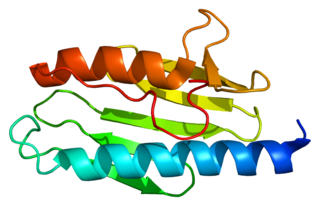
Taxaceae, commonly called the yew family, is a coniferous family which includes six extant and two extinct genera, and about 30 species of plants, or in older interpretations three genera and 7 to 12 species.

Friedreich's ataxia is an autosomal-recessive genetic disease that causes difficulty walking, a loss of coordination in the arms and legs, and impaired speech that worsens over time. Symptoms generally start between 5 and 20 years of age. Many develop hypertrophic cardiomyopathy and require a mobility aid such as a cane, walker, or wheelchair in their teens. As the disease progresses, some affected people lose their sight and hearing. Other complications may include scoliosis and diabetes mellitus.
Paraneoplastic cerebellar degeneration (PCD) is a paraneoplastic syndrome associated with a broad variety of tumors including lung cancer, ovarian cancer, breast cancer, Hodgkin’s lymphoma and others. PCD is a rare condition that occurs in less than 1% of cancer patients.

Distal myopathy is a group of rare genetic disorders that cause muscle damage and weakness, predominantly in the hands and/or feet. Mutation of many different genes can be causative. Many types involve dysferlin.
A clinically isolated syndrome (CIS) is a clinical situation of an individual's first neurological episode, caused by inflammation or demyelination of nerve tissue. An episode may be monofocal, in which symptoms present at a single site in the central nervous system, or multifocal, in which multiple sites exhibit symptoms. CIS with enough paraclinical evidence can be considered as a clinical stage of multiple sclerosis (MS). It can also be retrospectively diagnosed as a kind of MS when more evidence is available.
Burton Drayer, MD, FACR, FANN, is an American radiologist and nationally recognized authority on the use of computed tomography and magnetic resonance imaging for diagnosing neurological disorders. From 2003 to 2008, he served as president, The Mount Sinai Hospital. As of 2020, he is the Charles M. and Marilyn Newman Professor and System Chair, Radiology, for The Mount Sinai Health System and Icahn School of Medicine at Mount Sinai Hospital in New York City.

Stephen L. Hauser is a professor of the Department of Neurology at the University of California, San Francisco (UCSF) specializing in immune mechanisms and multiple sclerosis (MS). He has contributed to the establishment of consortia that have identified more than 50 gene variants that contribute to MS risk.
David Eidelberg is an American neuroscientist who is a professor of Neurology and Molecular Medicine at the Zucker School of Medicine. He is a neuroscientist best known for applying functional imaging of the brain to study neurological diseases.
The Annals of Probability is a leading peer-reviewed probability journal published by the Institute of Mathematical Statistics, which is the main international society for researchers in the areas probability and statistics. The journal was started in 1973 as a continuation in part of the Annals of Mathematical Statistics, which was split into the Annals of Statistics and this journal.

Distal spinal muscular atrophy type 2 (DSMA2), also known as Jerash type distal hereditary motor neuropathy (HMNJ), is a very rare childhood-onset genetic disorder characterised by progressive muscle wasting affecting lower and subsequently upper limbs. The disorder has been described in Arab inhabitants of Jerash region in Jordan as well as in a Chinese family.
Distal hereditary motor neuropathy, Jerash type is a protein that in humans is encoded by the HMNJ gene.

CP-122,288 is a drug which acts as a potent and selective agonist for the 5-HT1B, 5-HT1D and 5-HT1F serotonin receptor subtypes. It is a derivative of the migraine medication sumatriptan, but while CP-122,288 is 40,000 times more potent than sumatriptan as an inhibitor of neurogenic inflammation and plasma protein extravasation, it is only twice as potent as a constrictor of blood vessels. In human trials, CP-122,288 was not found to be effective as a treatment for migraine, but its selectivity for neurogenic anti-inflammatory action over vasoconstriction has made it useful for research into the underlying causes of migraine.
Igor Koralnik is an American physician, neurologist and scientist. He is one of the first physicians to study the neurologic complications caused by the human immunodeficiency virus (HIV) and is a leading researcher in the investigation of the polyomavirus JC, which causes progressive multifocal leukoencephalopathy (PML), a disease of the central nervous system that occurs in immunosuppressed individuals.
Rhonda Renee Voskuhl is an American physician, research scientist, and professor. She is a member of the Brain Research Institute (BRI) at the David Geffen School of Medicine at UCLA and is the director of its Multiple Sclerosis Program. Voskuhl has published numerous scientific articles in academic journals and has served in the role of principal investigator for several treatment trials investigating potential treatments for multiple sclerosis (MS).
Radiologically isolated syndrome (RIS) is a clinical situation in which a person has white matter lesions suggestive of multiple sclerosis (MS), as shown on an MRI scan that was done for reasons unrelated to MS symptoms. The nerve lesions in these people show dissemination in space with an otherwise normal neurological examination and without historical accounts of typical MS symptoms.

LATE is a term that describes a prevalent condition with impaired memory and thinking in advanced age, often culminating in the dementia clinical syndrome. In other words, the symptoms of LATE are similar to those of Alzheimer's disease.

Gladys Elena Maestre is a neuroscientist from Venezuela who is a professor at the University of Texas Rio Grande Valley School of Medicine. She is known for her work on Alzheimer's disease and other forms of dementia.
Nicole Schupf is an American epidemiologist and neuroscientist who is Professor of Epidemiology in Neurology, Psychiatry, the Gertrude H. Sergievsky Center, and the Taub Institute for Research on Alzheimer's Disease and the Aging Brain, Columbia University Faculty of Medicine. She studies aging and Alzheimer's disease in individuals with Down syndrome.
The Human Biology Association (HBA), established as the Human Biology Council in 1973, is a scientific and nonprofit organization for the promotion of studies in human biology. It is headquartered at Washington, D.C., US. Its official journal American Journal of Human Biology is published by Wiley. In the past it had also supported the publication of Human Biology, which was the main reason for its establishment.
Lesion network mapping is a neuroimaging technique that analyzes the connectivity pattern of brain lesions to identify neuroanatomic correlates of symptoms. The technique was developed by Michael D. Fox and Aaron Boes to understand the network anatomy of lesion induced neurologic and psychiatric symptoms that can not be explained by focal anatomic localization. Lesion network mapping applies a network-based approach to identify connected brain networks, rather than focal brain regions, that correlate with a specific symptom.







